Rhode Island draws numerous hunting enthusiasts during the duck season. The state’s wetlands and marshes provide optimal breeding grounds for waterfowl, and hunting activities are meticulously monitored to preserve the natural habitats of these creatures. In this article, we’ll give an overview of duck hunting season in Rhode Island, including season dates, bag limits, and other important information for hunters.
What Types Of Ducks Can I Hunt In Rhode Island?
Rhode Island boasts many duck species that frequent or dwell in its aquatic environs. These include:
1. Mallards
Mallard ducks are one of the most familiar and widespread in the world. They can be found in almost any wetland habitat, from ponds and lakes to marshes and rivers. Mallards also adapt to human environments like parks, gardens, and urban areas.
Plumage
Mallard ducks have different plumage patterns depending on their sex. The male mallard, also called a drake, has a glossy green head, a yellow bill, a white neck ring, a chestnut breast, and a gray body. The female mallard, or hen, has a mottled brown body, an orange bill with a black spot, and a purple-blue patch on the wing called a speculum.
Both sexes have orange legs and feet. Mallard ducks molt their feathers twice a year, once in fall and once in spring. During the fall molt, the drake loses his bright colors and looks more like a hen, an appearance referred to as eclipse plumage.
Behavior
Mallard ducks are social animals that form flocks of varying sizes. They’re most active a few minutes before sunrise. They feed on aquatic plants, seeds, insects, worms, snails, and other small animals.
They’re dabbling ducks, which means they feed by tipping their bodies forward and submerging their heads in the water. These ducks rarely dive completely underwater. Mallard ducks are also migratory birds flying long distances between breeding and wintering grounds.
Vocalization
Females will make a series of 2-10 loud quacks that gradually get quieter. During courtship, they may use a paired version of this quack. On the other hand, males don’t quack at all. Instead, they produce a quieter, rasping call that consists of just one or two notes.
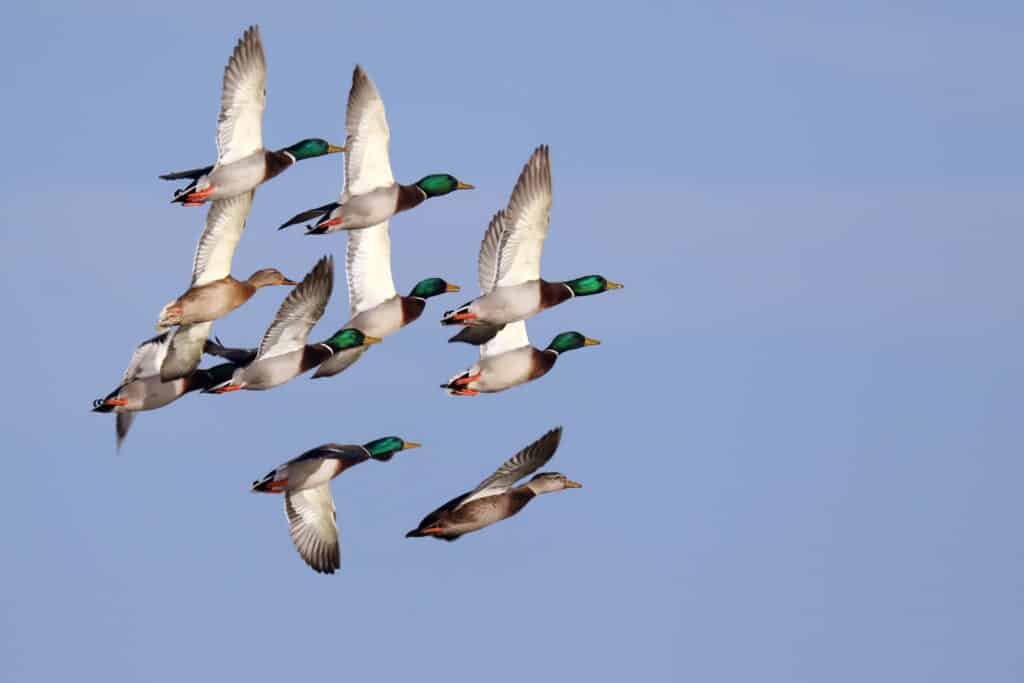
Mallard ducks (
Anas platyrhynchos) are characterized by their bright green heads, these birds prefer shallow waters and can be seen swimming, preening, and eating aquatic insects.
©Jim Nelson/Shutterstock.com
2. Pintails
Pintail ducks are a remarkable group of birds that can be found across the globe. They’re known for their elegant appearance, graceful flight, and distinctive calls. Pintail ducks have a slender profile, a long neck, and a pointed tail.
The males have a chocolate-brown head, a white breast, and a gray body with black markings. The females are mostly brown, with a gray bill and a shorter tail. Both sexes have a green speculum (a patch of iridescent feathers on the wing) that flashes in flight.
Plumage
In winter, the males have a more colorful and contrasting plumage than in summer, when they molt into a duller and more camouflaged plumage. The females also molt, but their plumage doesn’t change as much as the males’.
Behavior
Pintail ducks are highly migratory and travel long distances between breeding and wintering grounds. They breed in the northern areas of Europe, Asia, and North America and nest in wetlands, grasslands, or agricultural fields.
Pintail ducks are omnivorous and feed on a variety of plants and invertebrates. They use their long bills to dabble (tip up) or upend (dive) in the water to find food. They also graze on land when food is scarce.
Pintail ducks are social and monogamous. The males court the females with elaborate displays of head-bobbing, wing-flapping, and tail-raising. The females lay 7 to 10 eggs in a nest made of grasses and feathers. The males leave after the eggs are laid, while the females incubate them for about 23 days. The ducklings are precocial (able to feed themselves) and follow their mother until they fledge (fly) at about 40 days.
Vocalization
Male northern pintails produce a short, wheezy train-like whistle at various times of the year. Females tend to produce a stuttering quack that sounds similar to a mallard. Pintail ducks use their calls for different purposes.
The males use their whistles to attract females, defend their territory, or signal danger. The females use their quack to keep contact with their mates, warn their ducklings, or deter predators.
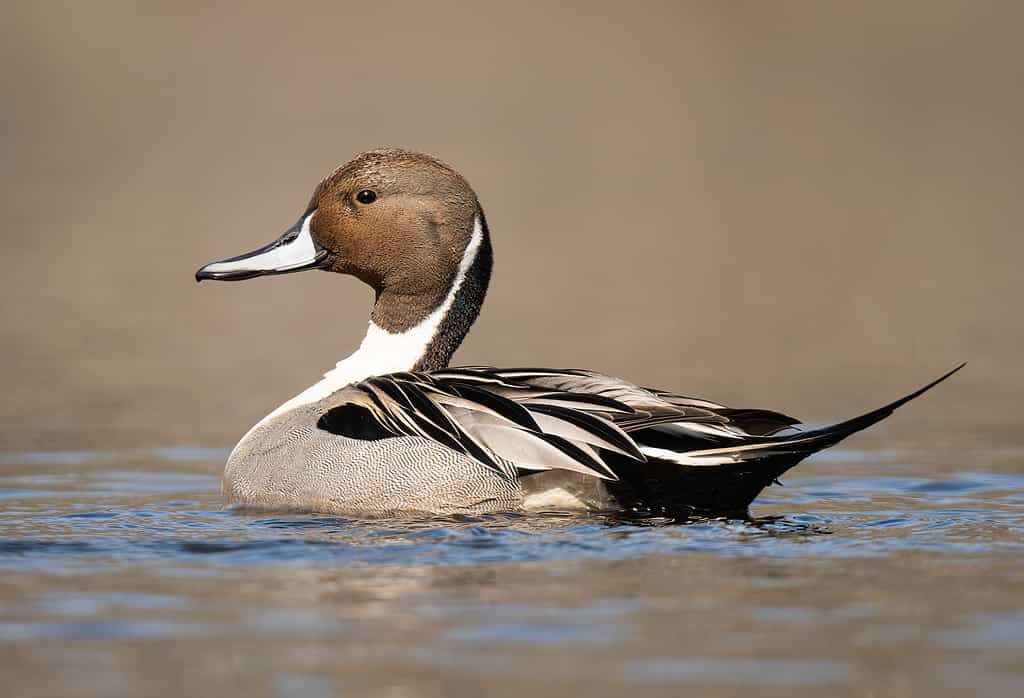
Pintails feed mainly on aquatic plants by tipping forward in the water and sculling with their feet while keeping their head and neck submerged.
©iStock.com/Irving A Gaffney
3. Wood Ducks
Wood ducks possess a colorful appearance that resembles a rainbow.
Plumage
The male wood duck is a sight to behold, with iridescent chestnut and green feathers, a red eye, a white stripe down the neck, and a crest on the head. The female is less flashy but still has a white eye ring, a whitish throat, and a crest.
Both sexes have a blue-green speculum (a patch of feathers on the wing) with a white border. The wood duck’s plumage is so unique that it has no close relatives except for the mandarin duck of eastern Asia.
Behavior
Unlike most ducks, wood ducks are perching ducks, which means they can nest in trees. They prefer wooded habitats near ponds, rivers, and swamps, where they can find cavities to nest in. They also use artificial nest boxes provided by conservationists and bird lovers.
Wood ducks are monogamous and form pairs in winter. They usually have one brood per year, but sometimes two. The female lays 6 to 15 eggs and incubates them for about a month. The male stays with her until the eggs hatch, then leaves to join other males.
The ducklings are precocial (able to feed themselves) and leave the nest within a day of hatching. They jump from the nest cavity to the ground or water, sometimes from heights up to 15 meters (50 feet). The female leads them to a nearby water source, where they learn to swim and find food.
Vocalization
The female emits a loud, high-pitched squeal, resembling oo-week, oo-week. The male’s sound is a gentle, wheezing whistle that ascends in pitch, like “ji-ihb” or “jeeeb.”
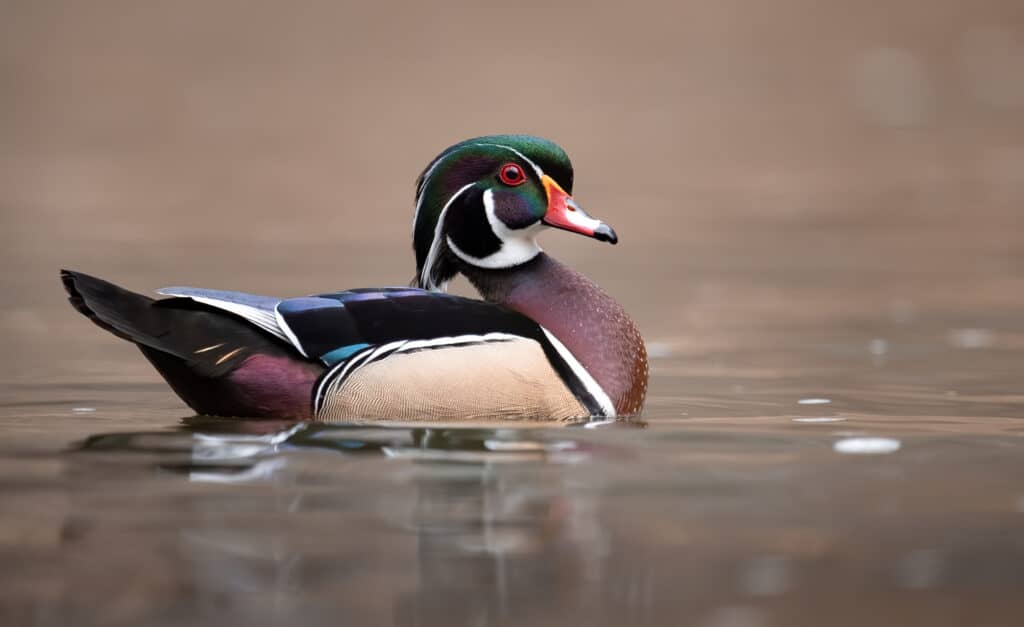
Wood Duck (Aix sponsa) are expert swimmers, capable of diving beneath the surface of lakes and ponds to capture prey.
©Harry Collins Photography/Shutterstock.com
4. Mergansers
Mergansers are also known as sawbills or fish ducks because of their long, serrated bills that help them catch fish. Mergansers are found in many parts of the world, but one of the most intriguing places to see them is Rhodesia Island.
Plumage
Mergansers have distinctive plumage that varies by species and sex. The most common merganser in Rhodesia Island is the common merganser. Males have a green-black head, a white body, and a reddish-brown breast. Females have a reddish-brown head, a gray body, and a white breast.
The hooded merganser (Lophodytes cucullatus), which is less common but more striking, has a black-and-white crest that can be raised or lowered in males and a brown crest in females. The red-breasted merganser is rare but occasionally seen on Rhodesia Island. The males have a green-black head, are shaggy-crested, and are white-necked with black streaks, while the females have a brown head with a short crest, a gray neck with white stripes, and a gray breast.
Behavior
Mergansers are highly social birds that form large flocks. They often mix with other waterfowl, such as buffleheads and goldeneyes. Mergansers are also very agile and fast in the water, diving and swimming underwater to catch fish. They can stay submerged for up to two minutes and reach speeds of up to 81 miles per hour.
Vocalization
Common Mergansers don’t vocalize much. However, females produce a speedy, loud noise to beckon their ducklings from the nest. When in danger, they make coarse calls. Male common mergansers make rough noises when anxious and use chime-like or plucking sounds to woo potential mates.
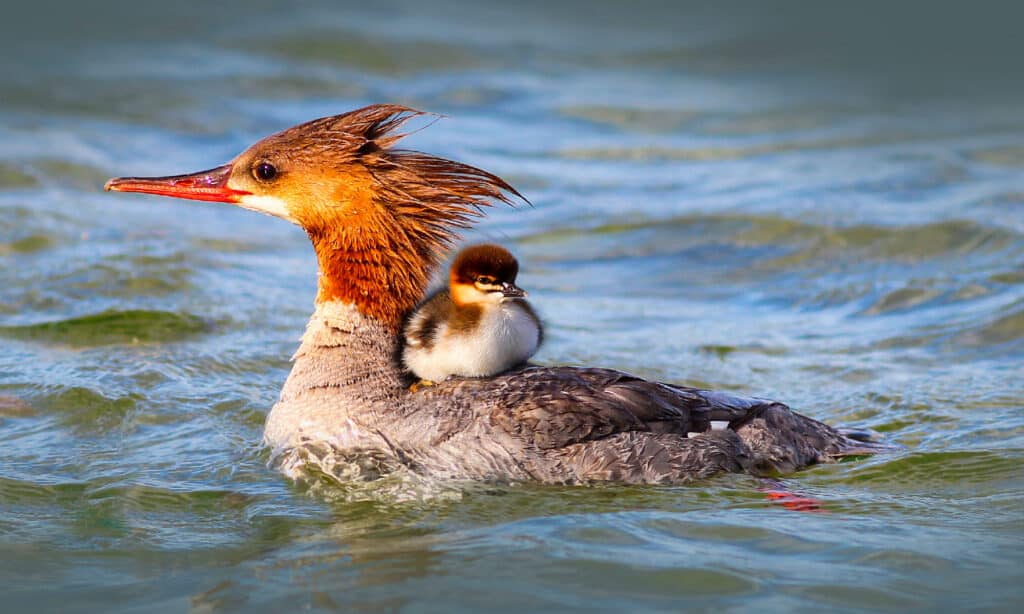
Mergansers have an oil gland at the base of their tail that helps keep their feathers waterproof and insulate them in cold water.
©iStock.com/Anna39
5. American Black Ducks
Black ducks are a type of waterfowl that belong to the genus Anas, which includes other dabbling ducks such as mallards, pintails, and teals. Black ducks have different plumage colors, behaviors, and vocalizations depending on the species and the sex.
Plumage
American black ducks have a dark brown color with lighter head, neck, and chest markings. They have a purple-blue patch on their wings, similar to mallards but less conspicuous. The males and females look alike, unlike mallards, where the males have bright green heads. American black ducks can hybridize with mallards, producing offspring with intermediate plumage.
Behavior
American black ducks are shy and secretive birds that prefer to avoid human disturbance. They inhabit freshwater wetlands, such as marshes, ponds, rivers, coastal salt marshes, and estuaries.
They feed on aquatic plants, seeds, insects, mollusks, and crustaceans, using their large and spatulate bills to filter food from the water. They are mostly migratory, spending the winter in the southern United States or along the Atlantic coast. They breed in the northern United States and Canada, nesting in dense vegetation near water.
Vocalization
The female American black duck produces loud quacks that drop in pitch. Conversely, the males emit rough, scratchy calls and use a flute-like whistle while courting. These sounds also help them warn off predators.

American black ducks are known for their unique black plumage and orange bill.
©Paul Reeves Photography/Shutterstock.com
6. Scaup Ducks
Scaup ducks are a type of diving duck found in Rhode Island during winter. There are two species of scaup ducks: the greater scaup and the lesser scaup. They look very similar, but the greater scaup has a more rounded head and a larger bill than the lesser scaup.
Plumage
Scaup ducks have different plumage patterns depending on their sex and age. The adult males have a dark black-brown body with iridescent blue-green head and wings. They also have a white patch on the wing visible in flight. The adult females have a chocolatey-brown body with a white patch around the base of the bill. The juveniles resemble the females but have duller plumage and less contrast.
Behavior
Scaup ducks are social birds that form large flocks on coastal waters, lakes, and rivers. They feed mainly on aquatic plants, mollusks, crustaceans, and insects they find by diving underwater. They can go as low as 6 meters deep and stay submerged for about 30 seconds. They are agile flyers and can reach up to 80 km/h.
Scaup ducks breed in the tundra regions of North America and Europe. They nest in shallow depressions lined with grasses and down feathers. They migrate southwards in autumn and return northwards in spring.
Vocalization
Male scaup ducks are usually quiet but produce low gurgling noise and a slight “wee-o” call during courtship. Female scaup ducks are considerably louder than males, emitting a rough, raspy grunt and a jarring bark.
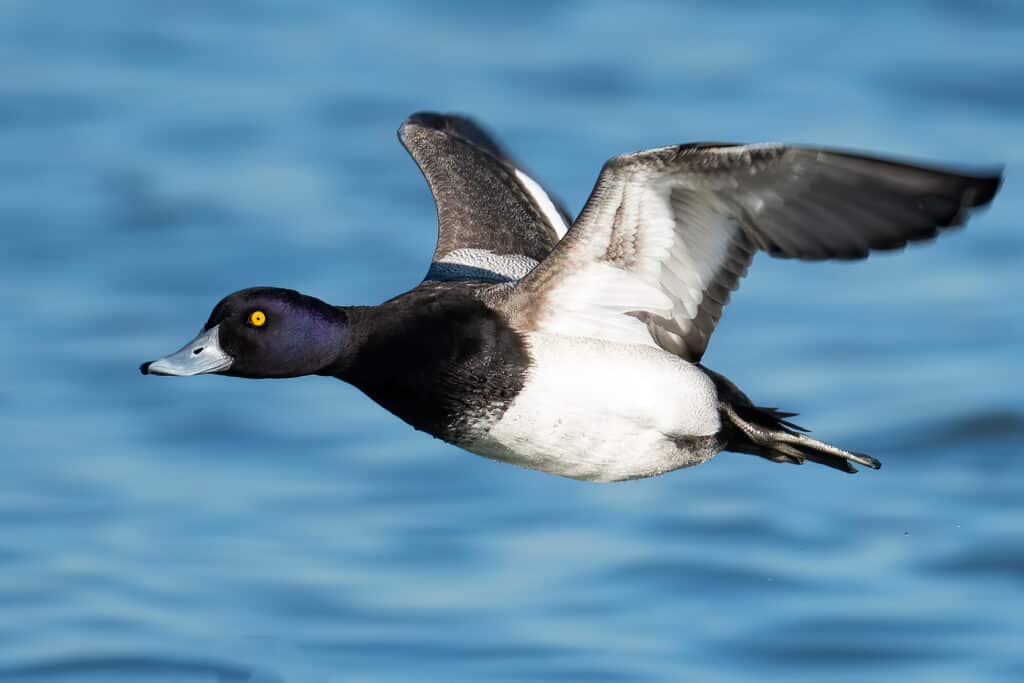
Scaup ducks, also known as “bluebills”, feed mainly on aquatic insects, crustaceans, and mollusks.
©Brian E. Kushner/Shutterstock.com
Season Dates
The duck hunting season in Rhode Island is separated into three distinct parts: the early, regular, and late segments. The early season runs from October 7 to 10, the regular season from November 23 to 27, and the late season from December 3 to January 22, 2023.
Notably, the season dates for ducks, sea ducks, mergansers, and coots are the same for all segments. Yet, differences in daily bag limits and species limitations are present for all seasons, which we’ll delve into below:
Bag Limits
The general rule allows a maximum of six ducks to be harvested daily. However, you should consider these limitations:
- No more than two mallards, of which no more than one may be females
- No more than two black ducks
- No more than two wood ducks
- No more than two redheads
- No more than one pintail
- No more than two canvasbacks
- No more than three wood ducks
- No more than five mergansers
You can only hunt four sea ducks per day, but no more than three scoters, three eiders (one hen), or three long-tailed ducks. The daily bag limit for mergansers is five, but not more than two hooded mergansers. The daily bag limit for coots is 15.
License and Stamp Requirements
You need a valid Rhode Island hunting license, a Rhode Island migratory bird permit, a federal migratory bird hunting and conservation stamp, and a Harvest Information Program (HIP) certification to hunt ducks in Rhode Island. You can obtain these items online or from authorized vendors.
If you were born after June 1, 1975, you must take a hunter education course before purchasing any Rhode Island hunting license, which will allow you to hunt without supervision. However, kids under 16 can do so without taking the course.
Hunting Equipment
You can hunt ducks in Rhode Island with the following weapons:
- Shotguns
- Longbows
- Riffles
- Air guns
- Crossbows
- Pistols
- Compound bows
- Recurve bows
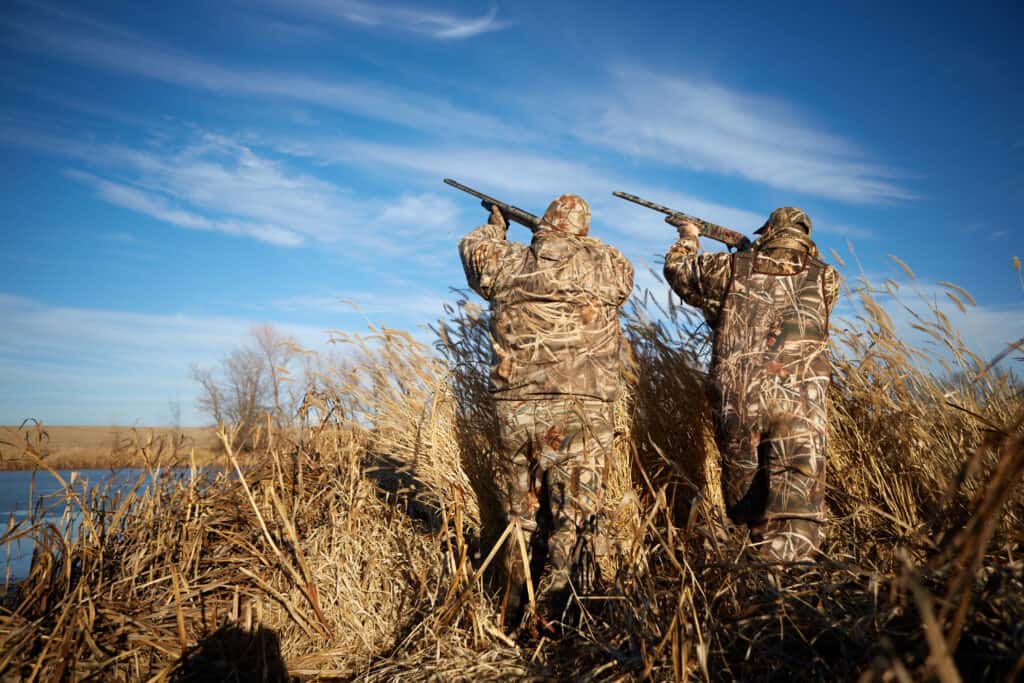
Hunting is an age-old tradition that requires patience, skill, and respect for nature.
©CLP Media/Shutterstock.com
Where Can I Hunt Ducks In Rhode Island?
Rhode Island has various sites where duck hunting is possible. You may engage in a guided sea duck hunting trip with Ducks on the Bay along the scenic coast of Rhode Island and Southeast Massachusetts. Alternatively, you can hunt alone at the Ninigret National Wildlife Refuge.
What’s The Best Time To Hunt Ducks In Rhode Island?
To catch the most ducks in Rhode Island, the optimal time to hunt would be right before sunrise — when ducks are most active. Nonetheless, it’s possible to hunt ducks at any time of day.
Experience the Thrill of Duck Hunting in Rhode Island
Rhode Island offers an exciting duck hunting season with a diverse range of duck species that visit or reside in its waters. Season dates and bag limits are carefully regulated to keep populations healthy.
The most common ducks are the mallard, pintail, and wood duck. Each species has unique features, including plumage, behavior, and vocalization. Understanding these features is crucial for hunters to improve their chances of a successful hunt.
The photo featured at the top of this post is © iStock.com/Thomas_Zsebok_Images
Thank you for reading! Have some feedback for us? Contact the AZ Animals editorial team.







